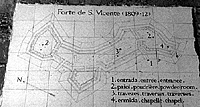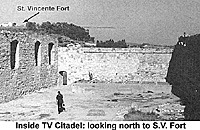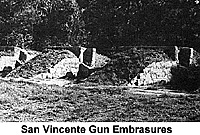Taking the coast road once past Sintra - a tourist trap, full of shops selling antiques at prices to make your head swim - we quickly put some miles behind us before passing Ericeira and the three forts, now dilapidated, at this coastal entry point. Where the river Laurenca comes in (about four miles further on) you can see the forts of the second line stretching away inland toward Mafra.
Restoration work at the castle didn't seem to have progressed much since my last visit in 1992. The steep scarped sides now hold a group of precariously placed houses and a very steep cobbled road. A good view can be had from the top of the valley of the Zizandro, which was dammed in several places to flood the ground.
Crossing the river, a road leads up the hillside to the San Vincente Fort. This fort was renovated and partly restored in 1992 due to a visit by the present Duke of Wellington.
In the town itself, a marble 'Cleopatra's needle' commemorates the Building of the Lines, the battles of Busaco, Rolica and Vimiero. Close by stands the Musee Municipal which has a permanent exhibition of prints, weapons, paintings and other items associated with the Lines, including a copy of the 'Electric' map of the one in the Castelo San Jorge in Lisbon, which shows through coloured lights and push-buttons the main and minor features of the Lines. A few of the exhibits are misleading, but it is well worth a visit.
After a monumental lunch at a cafe which can only be described as 'pro-British' (local Tovedro vinho tinto is 75p per bottle and tastes like best Bordeaux but a bottle has the effect of making military history slowly slide under the table) the next stop was out on the Mafra road to take a view of the enormity of the convent on Monte Igraca, about ten miles away.
This hill, and the one before it, Pero Negro, dominate the entire area and would have been a good place to watch Massena's army get the shock of its life as they 'bumped' into the hitherto unknown Lines on 12 October, 1810. Looking up at 'Fort 14', a vast entrenched camp and fort with supporting redoubts and batteries, you get a good impression of just how big and extensive the Lines are (three in total, although the third near Lisbon was intended only as a temporary holding-line to permit the army to embark). The planning, the work, the concept - for the time, monumental.
A few of the earth and masonry forts do have their little monumental pillars. You can sometimes spot these from the road. At other places they've gone completely - near the place we worked in Portugal, close to Arruda, there was a complex of roads, redoubts and forts but all very hard to distinguish due to the agricultural needs of the area in the present day.
This was my second visit to the area. It is sometimes rewarding to get out and explore. Several 'quintas' (farms with large estates and many buildings) housed troops and you sometimes get a surprise by poking around in them. as our military ancestors did, ask permission first! Unless you have unlimited time, a car is a necessity, although you must be prepared to scale some of the heights to explore thoroughly - don't be like Massena... have a Go!
Large Versions of Photos (extremely slow download: 376K)
 Having a few hours spare, and sitting near Sintra, it seemed the thing to do to go and explore further north - to the great Lines, built in 1810/11 by Wellington to keep the French out of Lisbon.
Having a few hours spare, and sitting near Sintra, it seemed the thing to do to go and explore further north - to the great Lines, built in 1810/11 by Wellington to keep the French out of Lisbon.
 Going on until you come to the River Zizandro, the road turned inland for Torres Vedras, the town that gave its name to the project as work began there first, and some months before the rest of the 'scheme'. Following the course of the river, the road winds through the countryside and you can follow the course of the first Line on the right along the hilltops.
Going on until you come to the River Zizandro, the road turned inland for Torres Vedras, the town that gave its name to the project as work began there first, and some months before the rest of the 'scheme'. Following the course of the river, the road winds through the countryside and you can follow the course of the first Line on the right along the hilltops.
 When you reach Torres Vedras, it is time to stop and explore on foot. The old Moorish castle at the town had its sides steeply scarped by Portuguese peasantry and a battery built on top. I couldn't find any trace of it today, except to point out where it should have been, to cover the approaches to the redoubt to the east, and to sweep the opposite hillside, which held a road going up to the Great Redoubt, the San Vincente fort, or Redoubts 20 - 23.
When you reach Torres Vedras, it is time to stop and explore on foot. The old Moorish castle at the town had its sides steeply scarped by Portuguese peasantry and a battery built on top. I couldn't find any trace of it today, except to point out where it should have been, to cover the approaches to the redoubt to the east, and to sweep the opposite hillside, which held a road going up to the Great Redoubt, the San Vincente fort, or Redoubts 20 - 23.
 Three old windmills were turned into powder magazines, and the hilltop turned into a fort mounting over 30 guns and garrisoned by over 1700 soldiers, mainly Portuguese Ordenanza. Halfway down to the main road, lies the remains of a half-moon battery, which has been turned into a sort of hanging garden prospect by the locals.
Three old windmills were turned into powder magazines, and the hilltop turned into a fort mounting over 30 guns and garrisoned by over 1700 soldiers, mainly Portuguese Ordenanza. Halfway down to the main road, lies the remains of a half-moon battery, which has been turned into a sort of hanging garden prospect by the locals.
 Mafra still holds the enormous convent that housed troops whilst the army was within the Lines. Our driver informed us that whilst on Portuguese army service , he served at Mafra as a 'rodent operative' due to the plague of poison-immune rat s in the cellars of the convent. The road from here winds back toward Sintra - you can glimpse on the heights the Palace at Quells where Sir John Moore met Sir Arthur Wellesley, in 1808.
Mafra still holds the enormous convent that housed troops whilst the army was within the Lines. Our driver informed us that whilst on Portuguese army service , he served at Mafra as a 'rodent operative' due to the plague of poison-immune rat s in the cellars of the convent. The road from here winds back toward Sintra - you can glimpse on the heights the Palace at Quells where Sir John Moore met Sir Arthur Wellesley, in 1808.
Back to Table of Contents -- First Empire #21
Back to First Empire List of Issues
Back to MagWeb Master Magazine List
© Copyright 1997 by First Empire.
This article appears in MagWeb (Magazine Web) on the Internet World Wide Web. Other military history articles and gaming articles are available at http://www.magweb.com